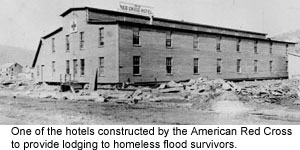 The international Red Cross movement was founded in 1863 in Switzerland with the primary goal of providing battlefield relief. Clara Barton, who had led some battlefield relief efforts during the Civil War, founded the American Red Cross in 1881. Barton believed the Red Cross could go beyond its original mission and also provide relief during peacetime disasters. The Johnstown flood of 1889 presented an ideal opportunity for the new organization to prove itself. Barton, 67, arrived with Red Cross workers from Washington, D.C., on June 5, 1889, just five days after the flood occurred. The Johnstown flood thus became the first major disaster relief effort for the American Red Cross.
The international Red Cross movement was founded in 1863 in Switzerland with the primary goal of providing battlefield relief. Clara Barton, who had led some battlefield relief efforts during the Civil War, founded the American Red Cross in 1881. Barton believed the Red Cross could go beyond its original mission and also provide relief during peacetime disasters. The Johnstown flood of 1889 presented an ideal opportunity for the new organization to prove itself. Barton, 67, arrived with Red Cross workers from Washington, D.C., on June 5, 1889, just five days after the flood occurred. The Johnstown flood thus became the first major disaster relief effort for the American Red Cross.
Today, the American Red Cross is a national organization with many local chapters. But at the time of the Johnstown flood, the Red Cross movement was relatively decentralized — in fact, the American Red Cross was not the only U.S. chapter of the international Red Cross movement, and there was no governing authority over Red Cross chapters.
Another newly-founded Red Cross chapter, the Philadelphia Red Cross, also rushed to Johnstown after the flood and established a headquarters separate from the American Red Cross. The two organizations were, apparently, competitive rather than cooperative — according to David McCullough’s The Johnstown Flood, “Barton spoke her mind once or twice to the head of the Philadelphia chapter of the Red Cross, with the result that within a few days neither group would have anything to do with the other.” The Philadelphia Red Cross specialized in medical relief, working out of the Cambria Iron Company’s hospital. By contrast, the most important work of the American Red Cross was to provide material relief to flood survivors in the form of furniture and supplies. Under Barton’s direction, the American Red Cross distributed new and used supplies valued at $211,000, and some 25,000 people were helped.
 In addition, the American Red Cross focused on providing shelter, building “Red Cross hotels,” the first of which was built on the site of the flood-destroyed St. Mark’s Episcopal Church on Locust Street (the church would later be rebuilt on the same site). Merchants and businessmen left homeless by the flood were the primary tenants of the hotel, and it was so successful that other hotels were soon built.
In addition, the American Red Cross focused on providing shelter, building “Red Cross hotels,” the first of which was built on the site of the flood-destroyed St. Mark’s Episcopal Church on Locust Street (the church would later be rebuilt on the same site). Merchants and businessmen left homeless by the flood were the primary tenants of the hotel, and it was so successful that other hotels were soon built.
In fact, providing shelter and food to displaced people is to this day the most important function of the American Red Cross in the immediate aftermath of a disaster.
Barton stayed in Johnstown until October 24, 1889, and the grateful people of Johnstown gave her a gold pin and a locket, set in diamonds and amethysts, as a farewell present. In 1892, Johnstown sent $2,596 to Barton to help with her efforts to relieve the Russian famine.
The exhaustive news coverage of the Johnstown flood and the relief effort helped establish the American Red Cross as the major disaster relief agency in the United States. The role the Johnstown flood played in the history of the Red Cross is another reason why the flood remains so significant in American history.
The Johnstown Flood Museum features a display about Barton and the Red Cross, including examples of some of the relief items she distributed, documents, photographs and more.
For more, visit the section about the 1889 flood in the Archives & Research section of this site.
More 1889 flood resources